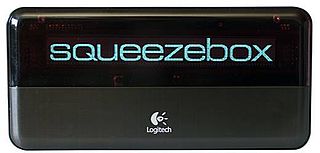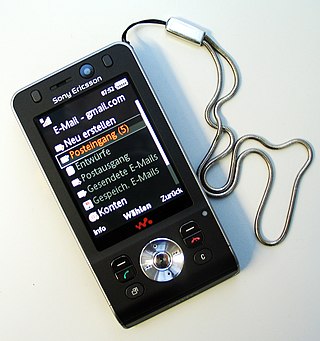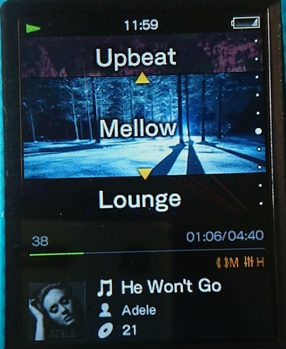
Walkman, stylised as WALKMAN (ウォークマン), is a brand of portable audio players manufactured and marketed by Japanese company Sony since 1979. The original Walkman started out as a portable cassette player and the brand was later extended to serve most of Sony's portable audio devices; since 2011 it consists exclusively of digital flash memory players. The current flagship product as of 2022 is the WM1ZM2 player.
Adaptive Transform Acoustic Coding (ATRAC) is a family of proprietary audio compression algorithms developed by Sony. MiniDisc was the first commercial product to incorporate ATRAC, in 1992. ATRAC allowed a relatively small disc like MiniDisc to have the same running time as CD while storing audio information with minimal perceptible loss in quality. Improvements to the codec in the form of ATRAC3, ATRAC3plus, and ATRAC Advanced Lossless followed in 1999, 2002, and 2006 respectively.

The iPod is a discontinued series of portable media players and multi-purpose mobile devices designed and marketed by Apple Inc. The first version was released on October 23, 2001, about 8+1⁄2 months after the Macintosh version of iTunes was released. Apple sold an estimated 450 million iPod products as of 2022. Apple discontinued the iPod product line on May 10, 2022. At over 20 years, the iPod brand is the oldest to be discontinued by Apple.

The iPod Shuffle is a discontinued digital audio player designed and formerly marketed by Apple Inc. It was the smallest model in Apple's iPod family, and was the first iPod to use flash memory. The first model was announced at the Macworld Conference & Expo on January 11, 2005; the fourth- and final-generation models were introduced on September 1, 2010. The iPod Shuffle was discontinued by Apple on July 27, 2017.

A portable media player (PMP) is a portable consumer electronics device capable of storing and playing digital media such as audio, images, and video files. The data is typically stored on a compact disc (CD), Digital Versatile Disc (DVD), Blu-ray Disc (BD), flash memory, microdrive, SD cards or hard drive; most earlier PMPs used physical media, but modern players mostly use flash memory. In contrast, analogue portable audio players play music from non-digital media that use analogue media, such as cassette tapes or vinyl records.
Gapless playback is the uninterrupted playback of consecutive audio tracks, such that relative time distances in the original audio source are preserved over track boundaries on playback. For this to be useful, other artifacts at track boundaries should not be severed either. Gapless playback is common with compact discs, gramophone records, or tapes, but is not always available with other formats that employ compressed digital audio. The absence of gapless playback is a source of annoyance to listeners of music where tracks are meant to segue into each other, such as some classical music, progressive rock, concept albums, electronic music, and live recordings with audience noise between tracks.

SonicStage is a discontinued software product from Sony that is used for managing portable devices when they are plugged into a computer running Microsoft Windows. It comprises a music player and library manager, similar to iTunes, Windows Media Player and RealPlayer. It is used to manage the library of ATRAC and MP3 recordings on a PC.

Squeezebox is a family of network music players. The original device was the SliMP3, introduced in 2001 by Slim Devices. It had an Ethernet interface and played MP3 music files from a media server. The first Squeezebox was released two years later and was followed by several more models. Slim Devices was acquired by Logitech in 2006.
The following comparison of portable media players compares general and technical information for notable digital playback devices.

The Sony Ericsson W910i is a slider model music phone. The W910i was announced on June 14, 2007, as a branded "Walkman phone" and uses version 3 of the 'Walkman Player'. The phone also features the shake control feature found on the W580 that enables music track switching by shaking the phone and also for Java ME based video games and applications using the JP-8.

SensMe is a proprietary music mood and tempo detection system created by Sony Corporation, and employed in numerous Sony branded products, including in some Walkman digital music players, the Media Go application, the PlayStation Portable, and Sony Ericsson and Sony Xperia handsets. It is named Omakase Channel (おまかせチャンネル) in Japan.

Sony Ericsson W205 is an entry-level dual-band GSM/GPRS Walkman phone with a focus on music playback. It was announced on 7 April 2009 under the marketing tag ‘your first Walkman phone’.

The Walkman X series is a portable music player designed and released by Sony in Japan in 2009. It was marketed as a high-end, internet-enabled model in the Walkman digital player family in 2009. The model debuted in Japan in April 2009, and then became available in North America, Europe, China and also other regions. The Walkman X series was the first Walkman device to feature a touch screen and S-Master digital amplifier technologies.
The Walkman S Series is a line of portable media players designed and developed by Sony, currently marketed in Japan. The S Series made their debut in the fall of 2006 and later were launched in other regions. Although the first generation of models had generic displays, all next generations of players of the S Series had TFT color displays and supported video playback. They were slightly cheaper than the flagship A Series but had more features than the E Series. The S Series was discontinued outside Japan in 2012 and continues solely in the domestic market.
The Walkman A Series is a flagship line of mid-range digital audio players (DAP) by Sony as part of its Walkman range. The A Series has been marketed since 2005, initially as the top spec Walkman players and since 2014 as a mid-range following the introduction of the ZX Series. The "A" originally stood for "All in one, Advanced, and Attractive".

The Walkman ZX Series is a line of premium high-end digital audio players designed and developed by Sony since 2013. It sits above the A Series and below the luxury WM1 Series in the Walkman range.

The Walkman F series is a discontinued portable media player manufactured as a part of Sony's Walkman line of music players, through two generations. They are high-res compatible players and run the Android operating system.
The Walkman E Series is a line of digital audio (DAP) and portable media (PMP) players, marketed by Sony as part of its Walkman range. E Series devices have been marketed since 2000, although in its current form since 2008 as entry-level, candybar styled players.














